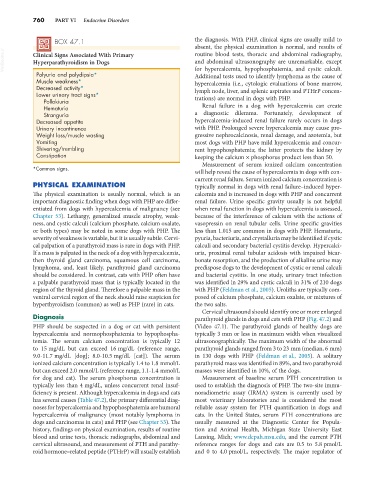Page 788 - Small Animal Internal Medicine, 6th Edition
P. 788
760 PART VI Endocrine Disorders
BOX 47.1 the diagnosis. With PHP, clinical signs are usually mild to
absent, the physical examination is normal, and results of
VetBooks.ir Clinical Signs Associated With Primary routine blood tests, thoracic and abdominal radiography,
and abdominal ultrasonography are unremarkable, except
Hyperparathyroidism in Dogs
Polyuria and polydipsia* for hypercalcemia, hypophosphatemia, and cystic calculi.
Additional tests used to identify lymphoma as the cause of
Muscle weakness* hypercalcemia (i.e., cytologic evaluations of bone marrow,
Decreased activity* lymph node, liver, and splenic aspirates and PTHrP concen-
Lower urinary tract signs*
Pollakiuria trations) are normal in dogs with PHP.
Hematuria Renal failure in a dog with hypercalcemia can create
Stranguria a diagnostic dilemma. Fortunately, development of
Decreased appetite hypercalcemia-induced renal failure rarely occurs in dogs
Urinary incontinence with PHP. Prolonged severe hypercalcemia may cause pro-
Weight loss/muscle wasting gressive nephrocalcinosis, renal damage, and azotemia, but
Vomiting most dogs with PHP have mild hypercalcemia and concur-
Shivering/trembling rent hypophosphatemia; the latter protects the kidney by
Constipation keeping the calcium × phosphorus product less than 50.
Measurement of serum ionized calcium concentration
*Common signs.
will help reveal the cause of hypercalcemia in dogs with con-
current renal failure. Serum ionized calcium concentration is
PHYSICAL EXAMINATION typically normal in dogs with renal failure–induced hyper-
The physical examination is usually normal, which is an calcemia and is increased in dogs with PHP and concurrent
important diagnostic finding when dogs with PHP are differ- renal failure. Urine specific gravity usually is not helpful
entiated from dogs with hypercalcemia of malignancy (see when renal function in dogs with hypercalcemia is assessed,
Chapter 53). Lethargy, generalized muscle atrophy, weak- because of the interference of calcium with the actions of
ness, and cystic calculi (calcium phosphate, calcium oxalate, vasopressin on renal tubular cells. Urine specific gravities
or both types) may be noted in some dogs with PHP. The less than 1.015 are common in dogs with PHP. Hematuria,
severity of weakness is variable, but it is usually subtle. Cervi- pyuria, bacteriuria, and crystalluria may be identified if cystic
cal palpation of a parathyroid mass is rare in dogs with PHP. calculi and secondary bacterial cystitis develop. Hypercalci-
If a mass is palpated in the neck of a dog with hypercalcemia, uria, proximal renal tubular acidosis with impaired bicar-
then thyroid gland carcinoma, squamous cell carcinoma, bonate resorption, and the production of alkaline urine may
lymphoma, and, least likely, parathyroid gland carcinoma predispose dogs to the development of cystic or renal calculi
should be considered. In contrast, cats with PHP often have and bacterial cystitis. In one study, urinary tract infection
a palpable parathyroid mass that is typically located in the was identified in 29% and cystic calculi in 31% of 210 dogs
region of the thyroid gland. Therefore a palpable mass in the with PHP (Feldman et al., 2005). Uroliths are typically com-
ventral cervical region of the neck should raise suspicion for posed of calcium phosphate, calcium oxalate, or mixtures of
hyperthyroidism (common) as well as PHP (rare) in cats. the two salts.
Cervical ultrasound should identify one or more enlarged
Diagnosis parathyroid glands in dogs and cats with PHP (Fig. 47.2) and
PHP should be suspected in a dog or cat with persistent (Video 47.1). The parathyroid glands of healthy dogs are
hypercalcemia and normophosphatemia to hypophospha- typically 3 mm or less in maximum width when visualized
temia. The serum calcium concentration is typically 12 ultrasonographically. The maximum width of the abnormal
to 15 mg/dL but can exceed 16 mg/dL (reference range, parathyroid glands ranged from 3 to 23 mm (median, 6 mm)
9.0-11.7 mg/dL [dog]; 8.0-10.5 mg/dL [cat]). The serum in 130 dogs with PHP (Feldman et al., 2005). A solitary
ionized calcium concentration is typically 1.4 to 1.8 mmol/L parathyroid mass was identified in 89%, and two parathyroid
but can exceed 2.0 mmol/L (reference range, 1.1-1.4 mmol/L masses were identified in 10%, of the dogs.
for dog and cat). The serum phosphorus concentration is Measurement of baseline serum PTH concentration is
typically less than 4 mg/dL, unless concurrent renal insuf- used to establish the diagnosis of PHP. The two-site immu-
ficiency is present. Although hypercalcemia in dogs and cats noradiometric assay (IRMA) system is currently used by
has several causes (Table 47.2), the primary differential diag- most veterinary laboratories and is considered the most
noses for hypercalcemia and hypophosphatemia are humoral reliable assay system for PTH quantification in dogs and
hypercalcemia of malignancy (most notably lymphoma in cats. In the United States, serum PTH concentrations are
dogs and carcinomas in cats) and PHP (see Chapter 53). The usually measured at the Diagnostic Center for Popula-
history, findings on physical examination, results of routine tion and Animal Health, Michigan State University East
blood and urine tests, thoracic radiographs, abdominal and Lansing, Mich; www.dcpah.msu.edu, and the current PTH
cervical ultrasound, and measurement of PTH and parathy- reference ranges for dogs and cats are 0.5 to 5.8 pmol/L
roid hormone–related peptide (PTHrP) will usually establish and 0 to 4.0 pmol/L, respectively. The major regulator of

